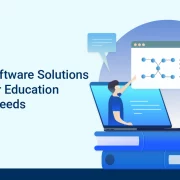
7 Educational Content Development Strategies for Higher-ed Institutions
Table of Contents:
- Introduction
- Top 7 Content Development Strategies for Higher-ed Institutions?
1. Devise a clear structure
2. Have a pre-defined purpose
3. Personalize your content
4. Incorporate video content
5. Offering content on mobile
6. Develop student-centric content
7. Collect feedback and revise - Final Thoughts
Introduction
Educational institutions across the globe are experiencing a digital transformation today. Due to the influx of social media platforms, user-generated content, and increased mobile access, students have become more empowered than ever.
Therefore, universities, schools, and other educational institutions need to future-proof the content strategy to keep up with the digital transformation. They need to comprehend students’ goals and needs, and then respond to those with engaging content.
These days, there are a myriad of platforms and channels to deliver content to the students. With the availability of different content formats, many educational institutes struggle to keep the content consistent and strategic.
Let us look at some of the content development strategies for higher-ed institutions through this blog post.
1. Devise a clear structure
Course creators in educational institutions often have to fit in plenty of information in a single eLearning course. Either intentionally or unintentionally, this creates an uninviting learning environment for students.
To foster an engaging online learning environment, course instructors must ensure that the content has a clear and consistent structure. Moreover, each module within a course should follow the same structure.
For example, collaborative opportunities, tasks, assignments, and reading materials should have the same format and location within the eLearning course. An important strategy you can incorporate is microlearning.
It’s a current trend in educational content development wherein you present content in the form of short-term assignments or small learning units that have a clear structure. The strategy is very effective when it comes to memory retention in students.
2. Have a pre-defined purpose
Before devising a strategy for educational content development, you have to think about its purpose. A strategy without a purpose is akin to shooting in the dark. You will find success with your content strategy because your actions will have a predefined direction.
Think about these elements while planning a content development strategy:
Goals: What do you aim to achieve with the eLearning course, and how would those goals align with your institutional objectives and priorities? If you do achieve success, what would it look like?
Audience: For whom are you creating the educational content?
Message: What do you hope to communicate through your content? What do you wish students to learn through this course?
3. Personalize your content
Personalization can help deliver exceptional content for classroom or online learning. It prioritizes a proper understanding of each student’s goals and needs so that the content can be tailored to address those unique goals and needs.
Personalized content enables students to learn independently and at their own pace.
In particular, Generation Y or millennials are driven by personalization. According to a study conducted by American Express, personalization is the best approach to engage with the millennial generation.
This is why universities and colleges customize their offerings to suit the needs and preferences of generation Y.
4. Incorporate video content
With many social media platforms out there, creating and sharing video content has gained massive popularity.
Established educational institutions such as Oxford University and Washington and Lee University use live streaming to deliver resources to their students, staff, and the general public. Offering valuable content for free may seem counter-intuitive.
However, that’s how pull marketing works. It builds public interest and showcases thought leaders and experts at your institution. This makes it one of the most pivotal educational content development strategies in today’s world.
5. Offering content on mobile
When we talk about educational content development in the 21st century, missing out on mobile-friendly content is a big mistake. The daily mobile usage of the millennial generation is rising by the year. In fact, Generation Z is the first mobile-first, digital-native generation. This is why prospective students expect responsive and dynamic content on mobile. Many of them even prefer to complete the application process from their cell phones.
Many educational institutions have thus rolled out mobile-friendly content for their students.
Others like Ohio State, Maryville University in the US, and the University of Westminster in the United Kingdom have distributed free iPads to empower students through mobile-responsive content.
6. Develop student-centric content
While generating user-centric content is important in general, incorporating this strategy in higher-ed is important. As mentioned before, Gen Z and millennial students lay great emphasis on personalization.
Therefore, creating content that resonates with your tech-savvy students is extremely important. They are habituated to on-demand, real-time information. Hence, you should make it easy for them to find the information they want in the course modules.
In addition to that, student-centric content improves participation, knowledge retention, performance, problem-solving skills, engagement, and more. Overall, it makes learning more fun since eLearning courses involve many different mediums, including practical assignments, podcasts, videos, etc.
These courses also have some group exercises which foster collaborative learning. Working with teachers/peers inculcates the spirit of teamwork which is an excellent quality to have in a professional environment.
A student-centric eLearning course with quizzes, games, challenges, and real-life examples increases the probability that students will retain the content.
7. Collect feedback and revise
To enhance the student learning environment, you need to improve your educational content development strategies continually.
The best way to evaluate whether your strategy worked or failed is to collect students’ feedback. Use that feedback to analyze the effectiveness of higher ed content and make changes along the way.
Final thoughts
When it comes to educational content development, there isn’t any single authoritative approach. As far as higher education is concerned, the content strategy is never approached via wide, comprehensive sweeps. Instead, you have to consider small wins and take intelligent, data-driven decisions to achieve successful outcomes. And collaborating with a content development partner that can not only plan the strategy but also create multi-device compatible, secure, and engaging higher-ed courses for you is the key!

Senior Vice President – Business Development
Over 25 years of experience in the edtech and workforce learning industry with strong skills in Business Development, Customer Relationship Management (CRM) and Strategy.







